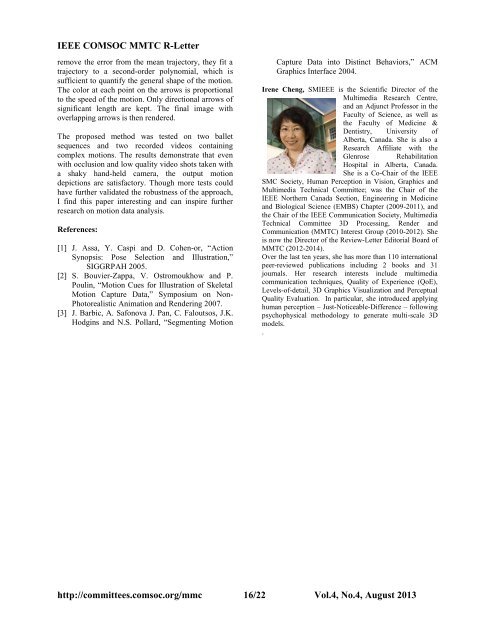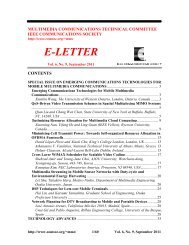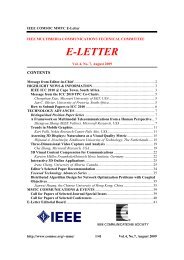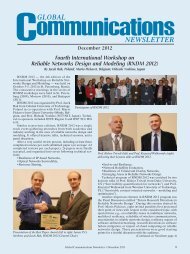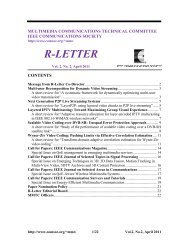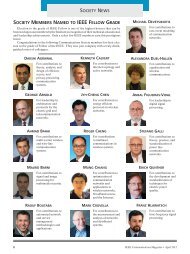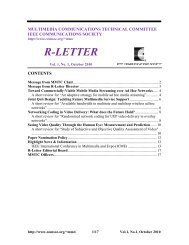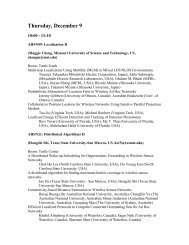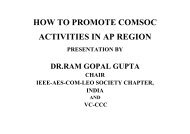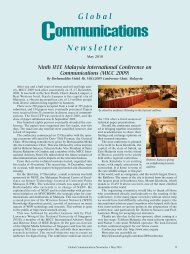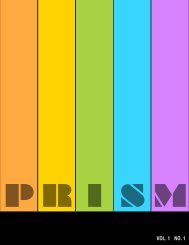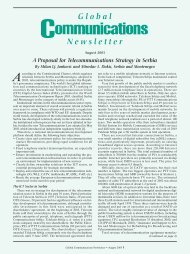<strong>IEEE</strong> COMSOC MMTC R-Letterremove the error from the mean trajectory, they fit atrajectory to a second-order polynomial, which issufficient to quantify the general shape <strong>of</strong> the motion.The color at each point on the arrows is proportionalto the speed <strong>of</strong> the motion. Only directional arrows <strong>of</strong>significant length are kept. The final image withoverlapping arrows is then rendered.The proposed method was tested on two balletsequences and two recorded videos containingcomplex motions. The results demonstrate that evenwith occlusion and low quality video shots taken witha shaky hand-held camera, the output motiondepictions are satisfactory. Though more tests couldhave further validated the robustness <strong>of</strong> the approach,I find this paper interesting and can inspire furtherresearch on motion data analysis.References:[1] J. Assa, Y. Caspi and D. Cohen-or, “ActionSynopsis: Pose Selection and Illustration,”SIGGRPAH 2005.[2] S. Bouvier-Zappa, V. Ostromoukhow and P.Poulin, “Motion Cues for Illustration <strong>of</strong> SkeletalMotion Capture Data,” Symposium on Non-Photorealistic Animation and Rendering 2007.[3] J. Barbic, A. Safonova J. Pan, C. Faloutsos, J.K.Hodgins and N.S. Pollard, “Segmenting MotionCapture Data into Distinct Behaviors,” ACMGraphics Interface 2004.Irene Cheng, SM<strong>IEEE</strong> is the Scientific Director <strong>of</strong> theMultimedia Research Centre,and an Adjunct Pr<strong>of</strong>essor in theFaculty <strong>of</strong> Science, as well asthe Faculty <strong>of</strong> Medicine &Dentistry, University <strong>of</strong>Alberta, Canada. She is also aResearch Affiliate with theGlenrose RehabilitationHospital in Alberta, Canada.She is a Co-Chair <strong>of</strong> the <strong>IEEE</strong>SMC <strong>Society</strong>, Human Perception in Vision, Graphics andMultimedia Technical Committee; was the Chair <strong>of</strong> the<strong>IEEE</strong> Northern Canada Section, Engineering in Medicineand Biological Science (EMBS) Chapter (2009-2011), andthe Chair <strong>of</strong> the <strong>IEEE</strong> Communication <strong>Society</strong>, MultimediaTechnical Committee 3D Processing, Render andCommunication (MMTC) Interest Group (2010-2012). Sheis now the Director <strong>of</strong> the Review-Letter Editorial Board <strong>of</strong>MMTC (2012-2014).Over the last ten years, she has more than 110 internationalpeer-reviewed publications including 2 books and 31journals. Her research interests include multimediacommunication techniques, Quality <strong>of</strong> Experience (QoE),Levels-<strong>of</strong>-detail, 3D Graphics Visualization and PerceptualQuality Evaluation. In particular, she introduced applyinghuman perception – Just-Noticeable-Difference – followingpsychophysical methodology to generate multi-scale 3Dmodels..http://committees.comsoc.org/mmc 16/22 Vol.4, No.4, <strong>August</strong> <strong>2013</strong>
<strong>IEEE</strong> COMSOC MMTC R-LetterIdentify Visualizable ConceptsA short review for ”Mining Visualness“Edited by Weiyi ZhangZheng Xu, Xin-Jing Wang, Chang Wen Chen, "Mining Visualness”, In ProceedingsInternational Conference on Multimedia & Expo (ICME) <strong>2013</strong> (Best Student Paper).Despite decades <strong>of</strong> successful research onmultimedia and computer vision, the semanticgap between low-level visual features and highlevelsemantic concepts remains a problem.Instead <strong>of</strong> generating more powerful features orlearning more intelligent models, researchershave started to investigate which concepts can bemore easily modeled by existing visual features[1, 2, 3]. To understand to what extent a concepthas visual characteristics, i.e. “visualness”, hasmany values. For instance, it can benefit recentresearch efforts on constructing image databases[4, 5]. These efforts generally attempt to attachimages onto pre-defined lexical ontology, whileexisting ontology were built without takingvisual characteristics into consideration.Knowing which concepts are more likely to findrelevant images will help save labors and controlnoises in database construction. Visualnessestimation is also useful for image-to-text [2, 6]and text-to-image [7] translation, e.g., words <strong>of</strong>more visualizable concepts are potentially betterannotations for an image.Albeit the usefulness, a general solution <strong>of</strong>visualness estimation faces many challenges: 1)It is unknown which concepts or which types <strong>of</strong>concepts are visualizable, i.e. whetherrepresentative images can be found to visualizeits semantics. For instance, “dignity” and“fragrant” are both abstract nouns, but the formeris more difficult to visualize as “fragrant” isclosely related to visual concepts such as flowersand fruits; 2) Different visual concepts havediverse visual compactness and consistency,especially for collective nouns (e.g., “animal”)and ambiguous concepts (e.g., “apple”, whichmay represent a kind <strong>of</strong> fruit or a company); and3) Even though a concept is highly visualizable,it may still be difficult to capture the visualcharacteristics due to the semantic gap. Fewprevious works in the literature have touched thisresearch topic. They either use pre-definedconcept list or insufficiently assumedprototypical concepts.In this paper, the authors attempt to discover andquantify the visualness <strong>of</strong> concepts automaticallyfrom a large-scale dataset. The quantitativemeasure <strong>of</strong> a concept is based on visual andsemantic synsets (named Visualsets), rather thana single image cluster or keyword as in previousworks. Visualsets perform disambiguation on thesemantics <strong>of</strong> a concept and ensures visualcompactness and consistency,which is inspiredby synsets in the work <strong>of</strong> ImageNet[4] andVisual Synsets[6]. In this paper's approach, avisualset is a group <strong>of</strong> visually similar imagesand related words, both are scored by theirmembership probabilities. Visualsets containprototypical visual cues as well as prototypicalsemantic concepts. Given the visualsets, thevisualness <strong>of</strong> a concept is thus modeled as amixture distribution on its correspondingvisualsets. Moreover, the authors discover bothsimple concepts (keywords) and compoundconcepts (combination <strong>of</strong> unique keywords)simultaneously from the generated visualsets.The proposed approach contains three steps: 1)build an image heterogeneous graph withattribute nodes generated from multitype features;Given a (noisily) tagged image dataset such as aweb image collection, the proposed schemeconnects the images into a graph to facilitate theclustering approach for visualsets mining.Specifically, the scheme extracts multiple types<strong>of</strong> visual features and textual feature for imagesto generate attribute nodes. The edges <strong>of</strong> thegraph are defined by links between images andattribute nodes instead <strong>of</strong> image similaritieswhich are generally adopted in previous works[2]. 2) mine visualsets from the heterogeneousgraph with an iterative clustering-rankingalgorithm; an iterative ranking-clusteringapproach is applied to form visual and textualsynsets, i.e. visualsets. In each iteration, it startswith the guess on image clusters. Based on theguess, the solution scores and ranks each imageas well as attribute nodes in each visualset.Images are then mapped to the feature spacedefined by the visualsets mixture model. Clustersare refined based on the estimated posteriors,http://committees.comsoc.org/mmc 17/22 Vol.4, No.4, <strong>August</strong> <strong>2013</strong>


